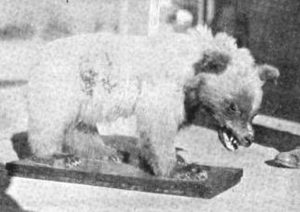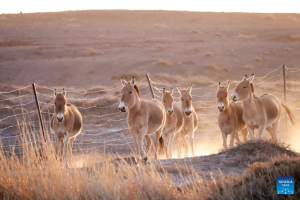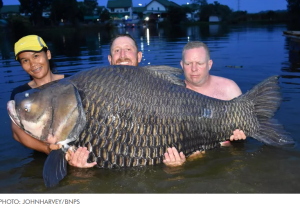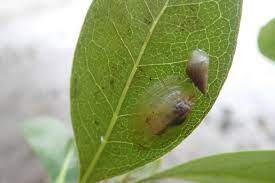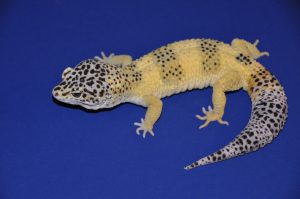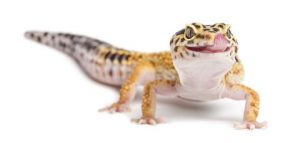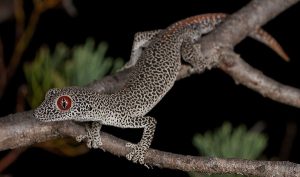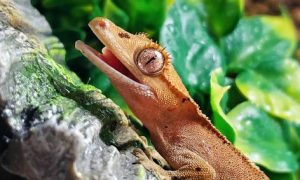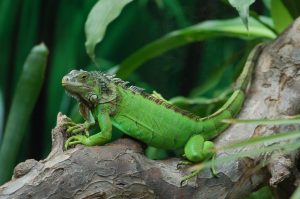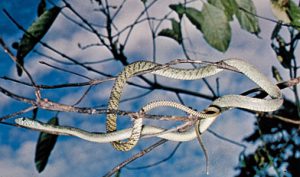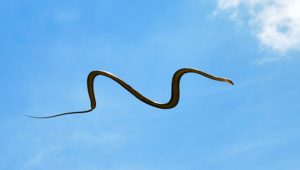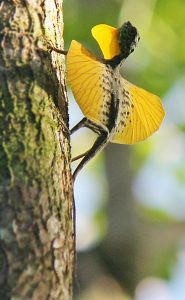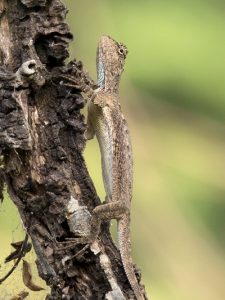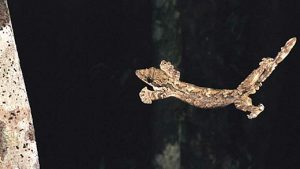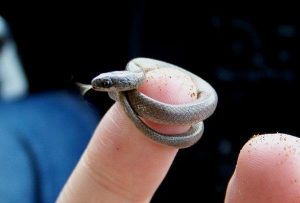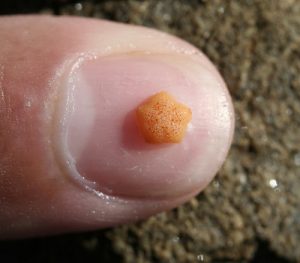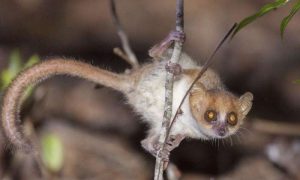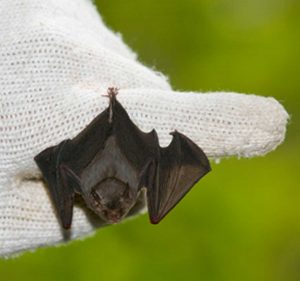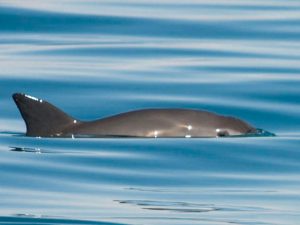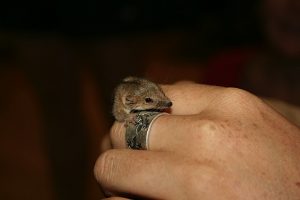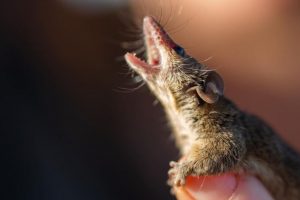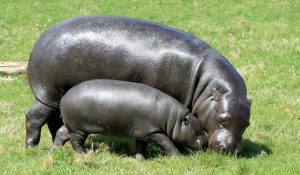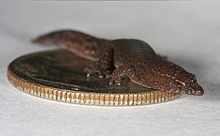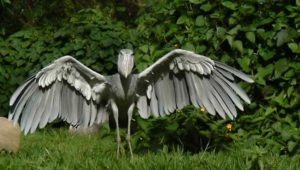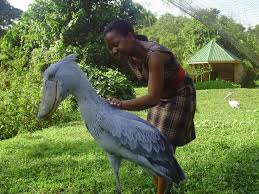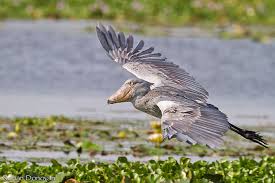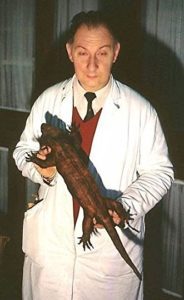Podcast: Play in new window | Download (Duration: 11:06 — 12.4MB)
Thanks for Preston and Pranav for suggesting this week’s topics!
Further reading:
DNA has revealed the origin of this giant ‘mystery’ gecko
Snow Leopards Dispersed Out of Tibetan Plateau Multiple Times, Researchers Say
Conquest of Asia and Europe by snow leopards during the last Ice Ages uncovered
The crested gecko AKA the eyelash gecko:
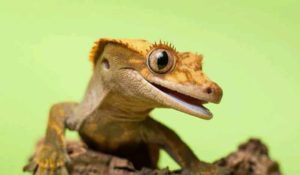
The fluffy snow leopard:
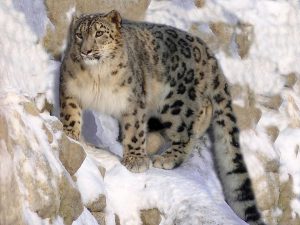
Show transcript:
Welcome to Strange Animals Podcast. I’m your host, Kate Shaw.
This week we have a couple of suggestions from Preston and one from Pranav! This is the first episode I’ve recorded in my new apartment, so let’s make it a good one.
First, Preston wanted to learn more about the crested gecko, mainly because he has a pet crested gecko named George Washington. That is one of the best gecko names ever!
The crested gecko is also called the eyelash gecko. We’ve talked about it a few times, but not recently at all. It’s native to a collection of remote Pacific islands called New Caledonia, where it spends most of its time in trees, eating insects and other small animals, but also fruit, nectar, and lots of other food. It’s an omnivore and nocturnal, and can grow more than 10 inches long, or 25 cm. It gets its names from the tiny spines above its eyes that look like eyelashes, and more spines in two rows down its back, like a tiny dragon. It can be brown, reddish, orange, yellow, or gray, with various colored spots, which has made it a popular pet. These days all pet crested geckos were bred in captivity, since it’s now protected in the wild.
The crested gecko has tiny claws on its toes, which is unusual since most geckos don’t have claws. It can drop its tail like other geckos if a predator is after it, but the tail doesn’t grow back. Since its tail is prehensile and helps it climb around in trees, you’d think the gecko would have trouble climbing after it loses its tail, but it doesn’t. Maybe that’s because in addition to claws, like other geckos it has basically microscopic hairlike structures on its toes that allow it to climb smooth surfaces like windows and walls and the trunks of smooth trees. It can also jump long distances to get to a new branch.
The crested gecko was discovered by science in 1866, but wasn’t seen after that in so long that people thought it was extinct. Then in 1994, a German herpetologist out looking for specimens after a tropical storm found a single crested gecko. It turns out that the geckos had been fine all along, but because they’re nocturnal and mostly live in trees, scientists just hadn’t spotted any.
While we’re talking about geckos, Pranav requested that we revisit Delcourt’s giant gecko with some updated information. We did mention the new findings back in episode 389, but it’s really interesting so let’s go over it again.
Way back in episode 20 we talked about Delcourt’s giant gecko, which is only known from a single museum specimen donated in the 19th century. In 1979 a herpetologist named Alain Delcourt, working in the Marseilles Natural History Museum in France, noticed a big taxidermied lizard in storage and wondered what it was. It wasn’t labeled and he didn’t recognize it, surprising since it was the biggest gecko he’d ever seen—two feet long, or about 60 cm. He sent photos to several reptile experts and they didn’t know what it was either. Finally the specimen was examined and in 1986 it was described as a new species.
No one knew anything about the stuffed specimen, including where it was caught. At first researchers thought it might be from New Caledonia since a lot of the museum’s other specimens were collected from the Pacific Islands. None of the specimens donated between 1833 and 1869 had any documentation, so it seemed probable the giant gecko was donated during that time and probably collected not long before. More recently there was speculation that it was actually from New Zealand, since it matched Maori lore about a big lizard called the kawekaweau.
In June of 2023, Delcourt’s gecko was finally genetically tested and determined to belong to a group of geckos from New Caledonia, the same archipelago of islands where the crested gecko is from. Many of its close relations are large, although not as large as it is. It’s now been placed into its own genus.
Of course, this means that Delcourt’s gecko isn’t the identity of the kawekaweau, since it isn’t very closely related to the geckos of New Zealand, but it might mean the gecko still survives in remote parts of New Caledonia. It was probably nocturnal and lived in trees, hunting birds, lizards, and other small animals.
Now we’re done with geckos for today, but we’re not done with this episode! Preston also wanted to learn about the snow leopard, and it’s amazing that we’ve never talked about it before! The snow leopard is a big cat that’s most closely related to the tiger, although they don’t look very much alike. The term big cat refers to tigers, lions, leopards, snow leopards, and jaguars, but it can also include cheetahs and cougars depending on who you ask. Big cats have round pupils instead of slit pupils like domestic cats and other smaller cats.
The snow leopard mostly lives in cold, mountainous areas in parts of Asia, from Siberia to India. It prefers to live in rocky areas where its coat pattern hides it from its prey. Its fur is thick and it can be anywhere from pure white to tan or gray, with black spots and rosettes. Its head is small, its legs relatively short, and its tail is very fluffy and incredibly long. A big male can grow up to 1.5 meters long, or 5 feet, plus a tail that’s almost as long as his body, but he’s only about two feet tall at the shoulder, or not quite 60 cm.
The snow leopard is well adapted to cold and snow. Fur grows on the underside of its paws to keep its feet warm, its paws are really large to act as snowshoes, and its ears are small and rounded to keep the tips from being frostbitten. Its long tail helps it balance when climbing over rocks. Its tail also stores fat, and is so long and fluffy that the snow leopard can use its tail as a blanket when it’s sleeping. Built-in blanket!
Unfortunately for the snow leopard, its thick, beautiful fur has been used as a blanket by humans for a long time, and it’s still sometimes killed for its fur even though it’s a protected species almost everywhere it lives. It’s also sometimes killed by farmers and herders who think the snow leopard will kill their livestock. It actually doesn’t attack livestock very often, and almost never attacks people. It eats small animals of various kinds depending on where it lives, like mice and rats, hares and rabbits, wild goats and sheep, marmots, deer, civets, and even rhesus macaques. It mainly only kills livestock where its wild prey has been reduced because of human activity. It’s also vulnerable to habitat loss and climate change.
Snow leopards are mostly solitary, although a mated pair will hunt together and of course the mother snow leopard teaches her babies to hunt as they get older. Individuals leave scent marks and spray urine to let other snow leopards know they’re around. Males roam widely but females usually stay to a territory that they’re familiar with, although the territory may be quite large.
Most snow leopard cubs are born in the early summer, and a female usually only has two or three babies in a litter. The mother takes care of her babies by herself. She makes a den among rocks and lines it with her belly fur, but cubs are born with a lot of fur already to keep them warm. The mother takes care of them for about two years until they finally leave to find their own territories.
Lions, tigers, leopards, and jaguars can all roar. Snow leopards, cheetahs, and cougars can’t. But snow leopards, cheetahs, and cougars can purr, while lions, tigers, leopards, and jaguars can’t. The ability to roar is due to special adaptations in the larynx, but these adaptations also mean the animal can’t purr. So basically a cat can either roar or purr but not both and the snow leopard can purr.
We actually don’t know a whole lot about the snow leopard because it lives in such remote places, and one big mystery is how the snow leopard ended up adapted to cold. Most cats, large and small, prefer hot climates. Until recently, we didn’t even have any snow leopard fossils to give us a clue.
Then a collection of leopard fossils revealed some snow leopard fossils mixed in. They’re about a million years old, collected in parts of China, France, and Portugal. A study of the fossils, and a beautifully preserved partial skeleton found in Portugal, has shed light on the migration and evolution of the snow leopard.
The snow leopard was already well adapted for mountainous areas, but when the climate became colder during the Pleistocene, AKA the Ice Age, it evolved to thrive in a cold climate. It spread into many parts of Asia and Europe, especially mountainous areas, out-competing other predators like leopards that weren’t well adapted to cold. With the warming climate after the ice ages ended, the snow leopard was at a disadvantage and gradually died out except around the Tibetan plateau where it still lives today, and we’re very lucky to still have it.
You can find Strange Animals Podcast at strangeanimalspodcast.blubrry.net. That’s blueberry without any E’s. If you have questions, comments, or suggestions for future episodes, email us at strangeanimalspodcast@gmail.com. We also have a Patreon at patreon.com/strangeanimalspodcast if you’d like to support us for as little as one dollar a month and get monthly bonus episodes.
Thanks for listening!
